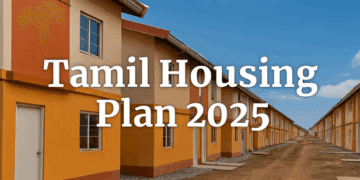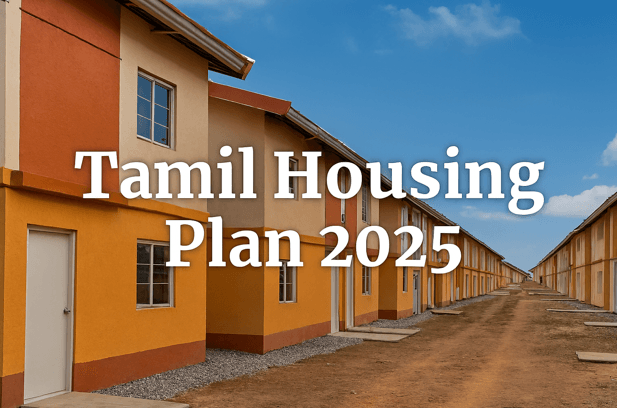The Government of India has unveiled a comprehensive housing initiative under the Tamil Housing Plan 2025, aimed at rehabilitating 14,000 displaced Tamil families. The announcement was made during a joint press briefing by the Ministry of External Affairs and the Ministry of Housing and Urban Affairs, signaling a strategic blend of humanitarian outreach and regional diplomacy.
Key Objectives
- Provide permanent housing to Tamil families affected by displacement
- Strengthen India’s cultural and diplomatic ties with Tamil communities
- Integrate housing with infrastructure, education, and healthcare access
Implementation Strategy
The housing units will be constructed in phases across Tamil Nadu and select districts in Sri Lanka’s Northern Province. The Tamil Nadu Urban Habitat Development Board (TNUHDB) will oversee domestic implementation, while MEA will coordinate with Sri Lankan authorities for cross-border execution.
Housing Allocation Table
| Region | Planned Units | Implementing Agency |
|---|---|---|
| Tamil Nadu (Chennai, Madurai, Tirunelveli) | 8,000 | TNUHDB |
| Northern Province (Jaffna, Kilinochchi) | 6,000 | MEA + Sri Lankan Housing Ministry |
Funding and Partnerships
The ₹1,200 crore budget will be sourced from central allocations, state contributions, and international development partners including ADB and UN-Habitat. Private contractors will be engaged through transparent bidding, with priority given to eco-friendly and disaster-resilient designs.
Historical Context and Legacy of Displacement
The Tamil Housing Plan 2025 is rooted in decades of displacement and marginalization faced by Tamil families, particularly those affected by civil conflict in Sri Lanka and internal migration within India. Many families in the Northern Province of Sri Lanka were uprooted during the civil war, while others in Tamil Nadu faced eviction due to urban expansion and environmental disasters. This housing initiative is not just infrastructural—it’s a long-overdue recognition of cultural identity and human dignity.
India has previously supported housing efforts in Sri Lanka through grants and technical assistance, but the 2025 plan marks the first time such efforts are being integrated with domestic rehabilitation programs. By linking Tamil Nadu and Northern Sri Lanka under a unified housing strategy, the government aims to create a transnational model of inclusive development.
Cross-Border Diplomacy and Regional Stability
The Tamil Housing Plan 2025 also serves as a diplomatic bridge between India and Sri Lanka. The joint implementation framework includes coordination between India’s Ministry of External Affairs and Sri Lanka’s Ministry of Urban Development. Regular bilateral meetings and technical exchanges are planned to ensure smooth execution and avoid political friction.
This initiative is expected to improve India’s soft power in the region, especially among Tamil-speaking populations. It also aligns with India’s broader Indo-Pacific strategy, which emphasizes humanitarian cooperation, regional stability, and cultural diplomacy.
Design Standards and Sustainability Goals
Each housing unit under the Tamil Housing Plan 2025 will adhere to modern design standards. The government has mandated the use of disaster-resilient materials, rainwater harvesting systems, solar panels, and energy-efficient layouts. The homes will be built to withstand cyclones, floods, and seismic activity, especially in coastal and hilly regions.
Architectural firms have been invited to submit modular designs that can be adapted to local terrain and cultural preferences. The goal is to avoid cookie-cutter layouts and instead promote community-specific aesthetics that reflect Tamil heritage.
Monitoring, Transparency, and Citizen Feedback
To ensure transparency, the government will launch a public dashboard tracking construction progress, fund utilization, and grievance redressal. Each housing cluster will have a local monitoring committee comprising residents, civil society members, and government officials. These committees will meet monthly to review milestones and address complaints.
Mobile apps and SMS-based feedback systems will be deployed to allow residents to report issues in real time. The Ministry of Housing will also conduct third-party audits every quarter to validate quality and compliance. This multi-layered monitoring framework is designed to prevent corruption, delays, and substandard construction.
Impact on Livelihood and Social Mobility
Beyond shelter, the Tamil Housing Plan 2025 is expected to catalyze livelihood opportunities. Each housing site will include skill development centers offering training in carpentry, tailoring, digital literacy, and small-scale entrepreneurship. Women-led self-help groups will be encouraged to run community kitchens, micro-finance units, and cooperative stores.
Children from these communities will benefit from proximity to schools and digital learning hubs. Health clinics will offer maternal care, immunization, and mental health services. The holistic design of these clusters aims to break the cycle of poverty and enable upward social mobility.
Conclusion: A Blueprint for Inclusive Nation-Building
The Tamil Housing Plan 2025 is more than a policy—it’s a blueprint for inclusive nation-building. By addressing historical injustices, promoting regional diplomacy, and embedding sustainability, the initiative sets a precedent for future rehabilitation programs. As construction begins, the real test will lie in execution, community ownership, and long-term impact. If successful, this plan could become a model for housing justice across South Asia.
Social Integration Measures
Each housing cluster will include schools, clinics, and vocational training centers. Special provisions will be made for widows, disabled individuals, and orphaned children. Community councils will be formed to ensure participatory governance and grievance redressal.
Conclusion
The Tamil Housing Plan 2025 represents a landmark effort to restore dignity and stability to displaced Tamil families. By combining infrastructure with social support, the initiative aims to create sustainable communities and reinforce India’s commitment to inclusive development.



















